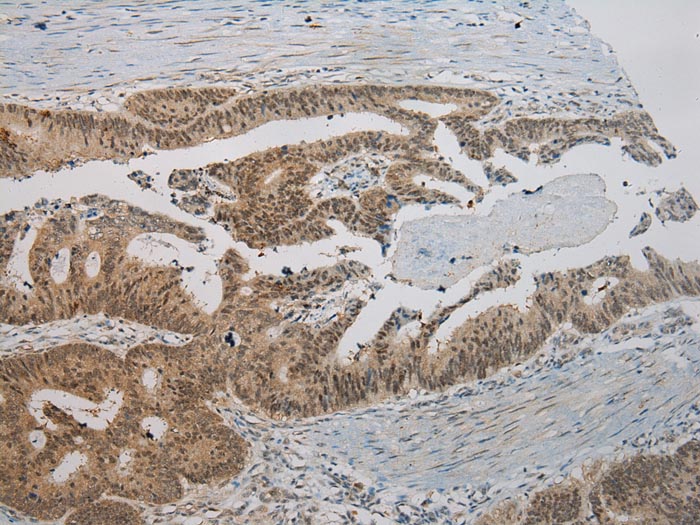

| WB | 咨询技术 | Human,Mouse,Rat |
| IF | 咨询技术 | Human,Mouse,Rat |
| IHC | 1/100-1/200 | Human,Mouse,Rat |
| ICC | 技术咨询 | Human,Mouse,Rat |
| FCM | 咨询技术 | Human,Mouse,Rat |
| Elisa | 咨询技术 | Human,Mouse,Rat |
| Aliases | HGPS; RIG1; HGPPS; RBIG1 |
| Host/Isotype | Rabbit IgG |
| Antibody Type | Primary antibody |
| Storage | Store at 4°C short term. Aliquot and store at -20°C long term. Avoid freeze/thaw cycles. |
| Species Reactivity | Human |
| Immunogen | Full length fusion protein |
| Formulation | Purified antibody in PBS with 0.05% sodium azide. |
+ +
以下是关于ROBO3抗体的3篇参考文献及其摘要概括:
---
1. **文献名称**:*Mutations in a human ROBO3 gene impair axon guidance in the developing nervous system*
**作者**:Jen JC, et al.
**摘要**:该研究通过ROBO3抗体检测发现,ROBO3基因突变导致蛋白表达异常,进而引发先天性眼动障碍(HGPPS),揭示了ROBO3在脑干轴突导向中的关键作用。
2. **文献名称**:*The divergent Robo family protein Robo3 is a critical regulator of axon guidance in the mammalian nervous system*
**作者**:Sabatier C, et al.
**摘要**:利用ROBO3抗体的免疫染色技术,发现Robo3通过调控Slit信号通路介导脊髓中线轴突交叉,缺失Robo3的小鼠表现为轴突导向缺陷。
3. **文献名称**:*Spatiotemporal expression patterns of Robo3 in the developing murine central nervous system*
**作者**:Marillat V, et al.
**摘要**:研究通过ROBO3抗体的免疫组化分析,系统描述了Robo3在小鼠胚胎期不同脑区(如脊髓、脑桥)的动态表达模式,提示其参与多阶段神经回路形成。
---
以上文献均涉及ROBO3抗体的实验应用,涵盖神经发育机制及疾病关联研究。如需具体期刊信息或补充文献,可进一步检索PubMed或SciHub。
The ROBO3 antibody targets the Roundabout Guidance Receptor 3 (ROBO3), a transmembrane protein critical in neural development. ROBO3. part of the Slit-Robo signaling family, regulates axon guidance and neuronal migration, particularly in the brainstem and spinal cord. It facilitates midline crossing of axons during embryogenesis by modulating Slit protein interactions. Unlike other Robo receptors, ROBO3 exists in two isoforms (ROBO3A and ROBO3B) with temporally distinct roles: ROBO3A promotes midline crossing pre-midline, while ROBO3B suppresses post-crossing axon responsiveness to Slit repulsion.
Mutations in the ROBO3 gene are linked to Horizontal Gaze Palsy with Progressive Scoliosis (HGPPS), a rare autosomal recessive disorder characterized by impaired horizontal eye movements and severe scoliosis. This underscores ROBO3's role in neurodevelopment.
ROBO3 antibodies are essential tools in neuroscience research, enabling detection of ROBO3 expression via techniques like Western blotting, immunohistochemistry, and immunofluorescence. They aid in studying neural circuit formation, developmental disorders, and potential therapeutic strategies. Specificity for ROBO3 isoforms is crucial, as cross-reactivity with other Robo proteins (e.g., ROBO1/2) may confound results. Commercial antibodies are typically validated in knockout models to ensure accuracy. Understanding ROBO3's function and regulation continues to advance insights into neurodevelopmental pathologies and axon guidance mechanisms.
×